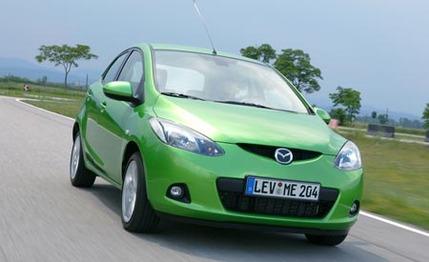 Mini Test Road Test
Mini Test Road Test
With gas prices having gone through the roof, subcompact economobiles are pouring into the U.S. market, from the 10Best-winning Honda Fit to the strong-selling Toyota Yaris to the upcoming Smart Fortwo. About the only company not setting foot into the diminutive class is Mazda-or for that matter, Mazda partner Ford. Other countries get pint-sized Mazdas and Fords, but not the U.S., at least not yet.
The Mazda 2, as the number implies, is a vehicle smaller than the Mazda 3. The '08 2 was developed on a platform designed in Japan, and the front-drive architecture will also underpin the 2008 Ford Fiesta. Now you're thinking, "We don't get that car, either," which is true, but under Ford boss Alan Mulally's global development plan, a Fiesta-sized car should arrive here in 2010. So although the Mazda 2 won't be coming to a Mazda dealer near you, how it drives and how it is made do bear examining because it is the basis for a Ford in our future.
Whereas most of the world's small cars get larger and heavier with each iteration, the Mazda 2 is actually at least 220 pounds lighter than its predecessor-an upright, undistinguished five-door hatchback. At a claimed 2100 pounds, the 2 is about 250 pounds less than the Yaris, the lightest car in a May 2006 comparison test of economy cars ["$15,000 Cheap Skates"]. Some of the weight saving comes from the Mazda's smaller size-at 153.1 inches long, the Mazda 2 is 4.3 inches shorter than a Fit. More weight reduction is a result of "feature adjustment," another way of saying the company pulled out features, so don't go looking for the Fit's trick folding rear seats-you won't find them.
More weight loss comes from the engineering department. The unibody is now more than 40-percent high-strength steel, which can be thinner and therefore lighter than mild steel. The suspension and the brakes reflect the cascade effect of weight saving: These pieces can be lighter because there's less mass to handle. The rest of the car was subjected to a strict "gram strategy," in which every part was analyzed to save fractions of a pound. Some of the saving came from surprising areas-like the 6.4 pounds shed because of a shorter wiring loom and the 2.2 pounds saved by the use of neodymium for the speakers instead of heavier ferrite.
This weight watching benefits not only the car's performance but also its fuel economy and CO2 emissions. The Mazda 2 now has a surprising agility, but the entire car is set up more for utility than sportiness. Quick steering (2.2 turns lock-to-lock) with electric assist gives a reactive feel, and there is a pleasing precision about the way the car turns into corners and tucks in if you lift off the throttle. Body roll is well controlled, and yet the ride is reasonably supple. Disc brakes up front and drums in back erase speed without drama. Mazda claims the 2's steering, brakes, and handling are best in class. We would say the Mazda is among the best; the Fit sets a very high standard.
Although the 2 is light, it does not feel flimsy. Mazda has gone to a lot of effort to correct a weak point of the previous gen-its excessive noise, vibration, and harshness. Road noise has been reduced by increasing body-shell rigidity, fitting a brace between the front strut towers, and paying careful attention to suspension bushings.
Our first drive was with the 102-hp, 1.5-liter four-cylinder engine that, like the 1.3-liter that will be more popular in Europe, has variable intake-valve timing. The 1.5-liter is a sweet, smooth power unit that works well with the slick-shifting five-speed manual. Japan will get a five-speed-automatic option.
A few words about the 2's styling, even if its shape won't be shared with Fords on the platform. Mazda has shown a series of concept cars emphasizing flowing forms and a wedgy profile. The Mazda 2's sides and hood have complicated, sculpted surfaces, and there is a hint of RX-8 in the front fenders. Rear overhang has been reduced to a minimum, so the car has a tight, sporty stance.
In Europe, Mazda hasn't really been a player among the smallest cars. The new 2 promises to change that-and bodes well for Fords that will share its essential elements.